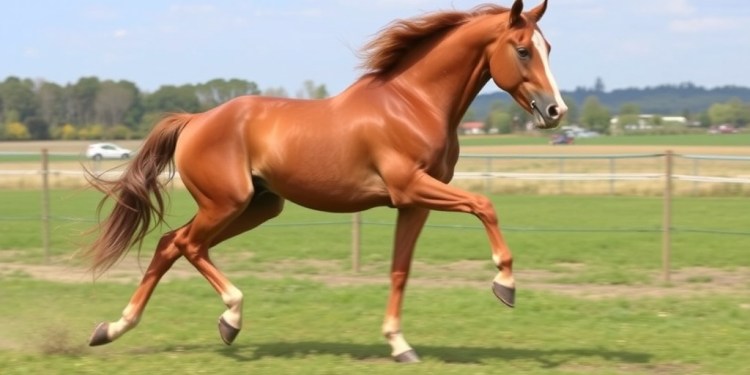Researchers have made a groundbreaking discovery about the genetic adaptations that contribute to the incredible endurance of horses. This significant finding is centered around a mutation in the KEAP1 gene, which not only enhances energy production but also provides a safeguard against cellular oxidative stress. By unveiling this unique evolutionary trait, the research emphasizes the potential implications it may have for human medicine and highlights a fascinating mechanism of adaptation that challenges previously held beliefs about vertebrate evolution.
Horses, long celebrated for their exceptional speed and endurance, boast remarkable physiological characteristics that enable them to perform as outstanding endurance runners. What sets them apart is their ability to efficiently take in, transport, and utilize oxygen, a trait that has been widely recognized as superior to that of elite human athletes. The maximal oxygen consumption (VO₂max) of horses is astonishingly more than twice that of the best human competitors, a testament to their extraordinary capabilities.
While the concentration of mitochondria in horse skeletal muscle is a crucial component that enhances energy production, it comes with a drawback. The increased mitochondrial activity leads to the production of reactive oxygen species (ROS), which can result in damaging tissue effects and cellular dysfunction. Understanding how horses have evolved mechanisms to manage the oxidative stress associated with their remarkable mitochondrial activity has been elusive until now.
To fill this knowledge gap, researchers led by Gianni Castiglione undertook an extensive evolutionary analysis of the KEAP1 gene, a critical regulator of redox balance and mitochondrial function, across 196 mammalian species. KEAP1 has emerged as a vital target in exercise science and has been implicated in various human health issues, including lung cancer and chronic obstructive pulmonary disease (COPD). The team’s comprehensive study reveals that modern horses, along with donkeys and zebras, have developed a unique adaptive feature involving a premature stop codon (UGA) in the KEAP1 gene.
This premature stop codon is not a detrimental error that truncates the protein as might typically be expected. Instead, the research reveals that horses have evolved a remarkable mechanism by which this stop codon is recoded efficiently into a cysteine amino acid (C15). This critical adaptation enhances the functionality of the KEAP1 protein, fundamentally altering its regulatory capacity. By mitigating the repression of NRF2—a protein essential for combating oxidative stress—this mutation leads to pronounced increases in mitochondrial respiration and ATP production.
The implications of this single-point genetic mutation are profound. Horses benefit from improved energy production while maintaining a careful balance with oxidative stress management. This stands in contrast to other mammals, where increased NRF2 activity can lead to detrimental effects. Thus, horses have managed to evolve a finely tuned adaptation that enhances their athletic performance, providing insights into the intricate relationship between genetics, energy metabolism, and oxidative stress.
The findings from Castiglione and colleagues open new avenues for understanding how specific genetic adaptations can contribute to extraordinary physical capabilities. The identification of the KEAP1 mutation and its functional consequences not only sheds light on equine physiology but also poses fascinating questions regarding its potential relevance to human health and performance.
This research underscores the significance of continued exploration into the genetic basis of endurance and athleticism in various species. The molecular mechanisms governing energy production and oxidative stress management could inform future approaches in sports science and medicine, paving the way for innovative strategies to enhance performance and mitigate diseases linked to oxidative stress in humans.
Moreover, the study emphasizes the evolutionary adaptability of vertebrates, showcasing how processes previously thought to be confined to viral adaptations can also be realized in mammals. The concept of recoding a de novo stop codon challenges established paradigms of genetic mutation and adaptation, suggesting a rich and complex evolutionary landscape waiting to be explored.
As the scientific community delves deeper into the implications of this research, it bears the potential to influence various fields, including genetics, exercise physiology, and even therapeutic strategies for diseases characterized by mitochondrial dysfunction and oxidative stress. The genetic blueprint unveiled in horses serves as a reminder of the intricate connections between evolution, adaptation, and performance that are ubiquitous in nature.
The revelation of the KEAP1 mutation as a significant factor underlying horse endurance adds a new layer to our understanding of genetic innovation in the animal kingdom. It demonstrates how a seemingly minor genetic alteration can yield substantial advantages, illustrating the delicate balance between evolution, environmental pressures, and physiological demands.
As we look to the future, the question remains—what other secrets might be hidden within the genomes of animals that enable extraordinary feats? This research serves as a catalyst for further investigations into the genetic determinants of endurance, providing hope for advancements in both animal performance and human health.
In conclusion, the study of the KEAP1 gene mutation in horses not only reveals a fascinating evolutionary adaptation but also suggests important implications for our understanding of athleticism across species. As researchers continue to uncover the complexities of genetic variations and their functional outcomes, we move closer to unlocking the full potential of genetic engineering and biotechnology in enhancing performance and treating diseases.
Subject of Research: Adaptation in horses’ endurance through KEAP1 gene mutation
Article Title: Running a genetic stop sign accelerates oxygen metabolism and energy production in horses
News Publication Date: 28-Mar-2025
Web References: DOI
References: N/A
Image Credits: N/A
Keywords: KEAP1 gene, endurance, horses, oxidative stress, energy metabolism, genetics, evolution, mitochondrial function, NRF2, adaptation, athletic performance.
Tags: endurance adaptations in horsesenergy production and athletic capabilitiesequine genetic research breakthroughsevolutionary adaptations in vertebratesimpact of genetics on horse racing performanceimplications of equine genetics for human medicineKEAP1 gene and athleticismmitochondrial activity in equine performanceoxidative stress in athletic horsesphysiological traits of exceptional endurance runnersrare genetic mutation in horsesVO₂max comparison between horses and humans





